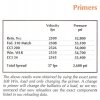As you can see -it's an abstract.
I have a theory that it's not the primer directly, but the primer AND your striking of it.
I once had a firing pin slipping within it's cocking piece. The ammo fired as normal, but suddenly ~2 out of 5 shots were throwing out of groups. This was intermittent(the pin moved back & forth here & there), not easy to find, but when I did, I had to determine where the pin was set when i had worked up the load. That's when I discovered that there is no standard here.
So I did firing pin setting testing, just like bullet seating testing, with my standard primer for the load (205 Feds).
My pin adjustments where measured as released pin protrusion from boltface. In this case the pin is secured with set screws.
What I observed was grouping opening and closing in apparent nodes.
I chose the tightest setting of course, and it ended up this problem turned into a blessing. I found grouping better than load development itself had produced.
The gun went from solid 3/8moa, to ~1/2moa (with the problem), to solid 1/4moa with the pin set at optimum for the primer. That's huge. I never would have arrived there without that testing.
Out of curiosity, I tried the same testing with CCIs, and the optimum setting was significantly different. But I had already comitted to Feds with this gun, so I went back to them with their best pin setting.
It would do no good to declare MY settings, as they would not likely be yours. My firing pins are different diameters, mass, driven by different springs, with different sear release, etc. It's a local abstract.

